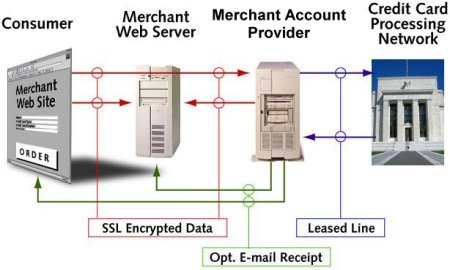Suggested Business Use: Internet and Mail Order/Telephone Order (MOTO)
When choosing a way of accepting credit cards, it essentially boils down to two choices: real-time processing and deferred processing. Real-time processing means the card is instantly approved. With deferred processing, the order is sent to you, the merchant, who then processes the order. Let’s examine the advantages and disadvantages of both methods.
Real-Time Processing (online Processing)
The biggest advantage with real-time processing is that the customer sees the results immediately. If you sell something that can be delivered online within minutes, such as software or data, real-time processing will allow you to complete the order within minutes. Online credit card processing also allows you to automate your business. This is especially valuable if your time is very limited. The more tasks you can automate, the better. The nice part is that you can have orders automatically or manually processed. For instance, let’s say someone visits your site, they find something they like but decide to call in the order instead of ordering online. All you have to do is open your web browser, log into your Real-Time account’s Virtual Terminal and manually type in the customers credit card information. If your business requires recurring billing, like an ISP or Web Host, then you’ll be pleasantly greeted with an option that allows you to automatically charge customer accounts at certain pre-set time intervals.
Real-time credit card processing also helps eliminate customer errors because they will receive immediate feedback on whether or not their card has been approved. If they made an error in entering their information such as a incorrect expiration date, they will receive immediate notice of the error, and they can correct it during the original transaction. Although this is not likely to occur in more than 2% of your orders, it can make a difference in your sales. Customers are much less likely to return to your site a few hours later to re-enter all their details if it takes that long for them to find out they made a mistake.
Secure Payment Gateways
In order to have your transactions processed in Real Time, your Web Site and Merchant Account will need to be linked together via a “Secure Payment Gateway.” All that these companies do is simply provide a secure connection between your Web Site and your Merchant Account Provider (processor). The largest companies of this type are not Merchant Account Providers (processors), so you may need to obtain a Secure Gateway account, and a Merchant Account from a compatible provider.
Real-Time purchase prices usually range from around no cost to $200. The pricing greatly depends on how much the Merchant Account Provider wants to profit off of a Real-Time sale.
How Online Transactions Are Processed
The process a transaction goes through is actually quite complicated; however, it only takes a few seconds. Here’s an inside look at how credit card transactions are processed using a Real-Time credit card processing solution:
1. The customer elects to proceed to the check-out with the items they placed into their shopping cart or selected from the order form on a merchant’s Website.
2. The customer then selects “credit card” as their method of payment.
3. Their browser connects to the Website host’s secure server, and brings up the secure payment form.
4. The customer enters in his or her credit card information on the secure payment form, and authorizes the transaction by clicking a “Complete Order” type button.
5. The transaction information flows to the Website host’s secure server using SSL encryption.
6. The secure server connects to the merchant’s processing bank either via a Secure Payment Gateway (a third party who provides the connection to the processing bank via land line), or directly (some processors have their own proprietary Secure Payment Gateway and, therefore do not require a third party to provide this service).
7. The processor polls the card network, such as Visa or MasterCard, directly, and the validity of the card, and availability of funds is confirmed.
8. If the transaction’s approved, an authorization code is returned to the processor, or to the Secure Payment Gateway from the processor.
9. The authorization is encrypted by the Payment Gateway or processor and transmitted in encrypted form to the Web server of the merchant, which triggers fulfillment of the order.
10. The merchant’s Web server then sends the customer’s browser a confirmation receipt.
11. The amount due is moved from the card holder’s bank to the merchant’s processing bank. The merchant’s processing bank will then move the money to the merchant’s local bank within 2 to 3 business days.
Here is a diagram of how Real-Time Credit Card Processing works:

For further detailed information check out the pages:
Pricing Information
Here are the rates and fees you can expect to pay for Real-Time credit card processing. (Note: Rates and fees may be higher or lower depending on what type of business you are operating, what country it’s located in, and your credit rating.)
| Application/Setup: | $0 – $100 |
| Real-Time Solution: |
$0 and up |
| Discount Rate: | 2.15% and up |
| Transaction Fee: | $0.25 to $0.35 |
| Monthly Minimum: | $0 – $25/month |
| Gateway Fee: | $0 – $20/month |
| Statement Fee: | $0 – $15/month |
| Chargeback Fee: | $5 – $25 per instance |
| Reserve: | Varies, ask provider for details |
Annual Fee: |
$0 – $100/year |
Advantages & Disadvantages
There are advantages and disadvantages to using any processing solution. Below is a table pointing these out for Real-Time Online processing:
| Advantages | Disadvantages |
|
|
|
|
|
Real-Time Payment Gateway Companies
In order for you to accept credit cards via your website you must have a payment gateway company connection between your sites order form and the processing bank. The gateway company acts as a “pipeline” to transfer the secured credit card information to the bank for processing and funds transfer to your merchant account.
There are quite a few payment gateway companies available to choose from. Depending on the Merchant Account Provider or bank you are working with will probably determine which payment gateway company you will be using to process your credit card transactions automatically. Some gateway companies can set you up directly with their services while others require you to go through one of their resellers. Some of the different payment gateway companies are:
- Merchant Warehouse
- AuthorizeNet
- VeriSign
Some gateways may have different features than others so check with the provider offering the service to be sure that a particular gateway option works for you
For more information on payment gateways:
Quick Tip:
- If a shopping cart system is not included with your real-time package; check with your merchant account provider to determine which shopping cart solutions will work with the particular gateway company you will be using.
Deferred Processing
If you do not deliver your products over the Internet, deferred processing may be the way to go for you. This is also called Offline Sales by some companies. The big advantage of using deferred processing is that you can manually review your orders and correct them if necessary before shipping. If you ship products to distant countries, you may find that the credit card issuer’s network is down. By using deferred processing, you’ll be able to call and authorize the transaction rather than declining it, which is what real-time processing would do. Though network outages are rare and shouldn’t be of major concern.
Using POS (Point Of Sale) software or terminals, you can handle transactions manually, over the Internet or by Mail Order/Telephone Order (MOTO). A disadvantage of deferred processing is that you need to download your orders securely, which requires daily attention on your behalf. It also means that until you download your orders, they are stored on the server – make sure that they are encrypted so that nobody can make sense of the information even if they do gain access of it. Don’t be fooled into taking the cheapest solution, which is hardware (swipe terminal). You’ll be forced to enter all your transactions manually, which can be a huge drain on your time. Don’t be tricked into paying more than $400 for a software solution. In most cases, you can get a POS software solution for less than $200. In addition, you shouldn’t have to pay for any programming or software setup services.
There are several POS software programs out there that will meet your deferred processing needs. PC Charge and ICVerify are among the most popular. For information and downloadable demos of these programs and more visit http://www.merchantseek.com/software/ What these programs do is connect you to your Merchant Account just like a POS Terminal would connect you. Unless you receive a high volume of orders, software processing will work just fine. Just make sure that you verify the credit card info before you ship. If you do real-time processing (explained previously), you can just use the Virtual Terminal instead, and everything is operated from your web browser.
It would be in your best interest to invest in both a Real-Time solution for online and Mail/Telephone orders (or a POS software solution if you prefer to process cards only manually), and a POS swipe terminal along with a Retail (Card Present-type) Merchant Account, if your company sells its products bothby retail (storefront, trade shows, etc.) and online. This way you’ll save money by processing your retail (face-to-face) transactions through the swipe terminal rather than having to pay the higher discount rate and per transaction fee for using only the online merchant account. It is also worth mentioning that many of the POS Software products support the addition of a card reader so that you can get the lower “Card Swipe” rates in card present situations.
One last important note worth mentioning, if you decide to use POS software to process your Internet orders be sure to use Electronic Commerce Indicators (within the POS software) to show which orders originated from the Internet. Visa and MasterCard now require that all orders via the Internet must be “flagged” as such. If you’re caught not indicating them, you can expect to pay some hefty fines. Be sure to read the software instruction manual on how to use Electronic Commerce Indicators or contact the company you bought it from for directions.
You will also want to be sure to use the Address Verification type Authorization requests for your online sales, otherwise Visa/MC will charge you an extra .50% to 1.25% on those transactions.






You must be logged in to post a comment.